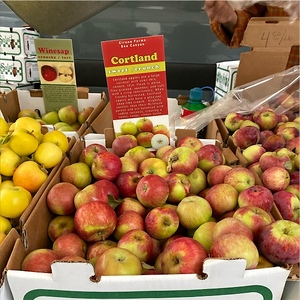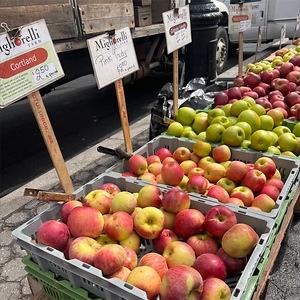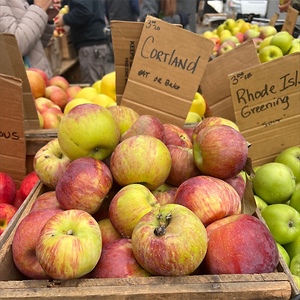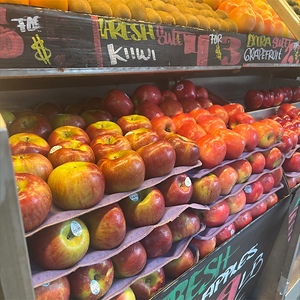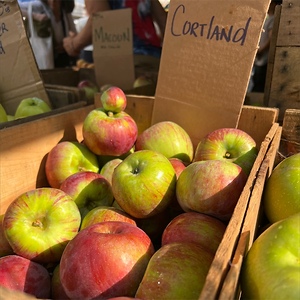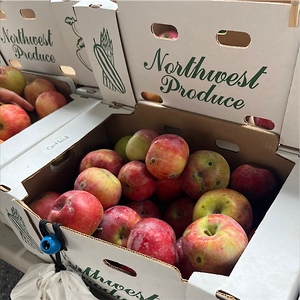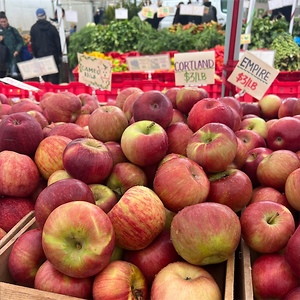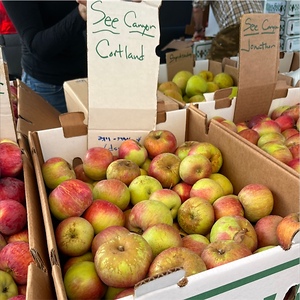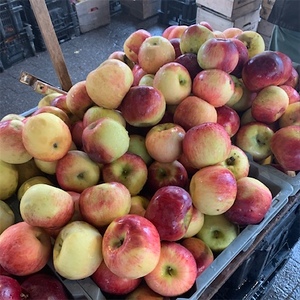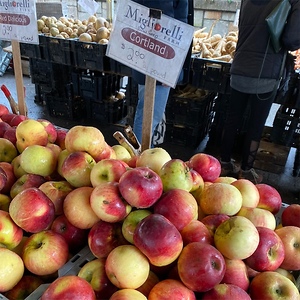

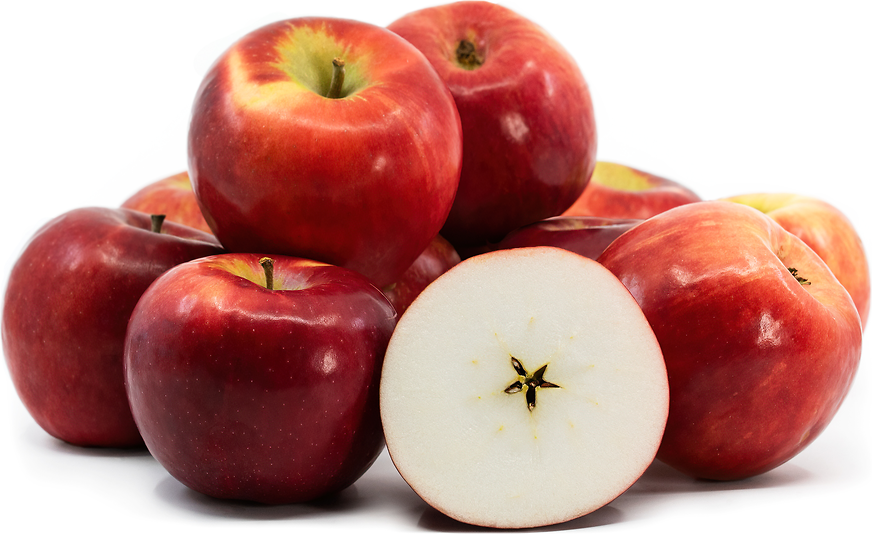
Cortland Apples
Estimated Inventory, lb : 0
Description/Taste
Cortland apples are a medium to large varietal with a flattened, round to conical appearance. The apple’s skin is semi-thin, smooth, and taut, showcasing a faint sheen that becomes greasy with age. The skin also has a yellow-green base hue, covered in bright red blushing and striping. It is common to see Cortland apples with green specks and some russeting, depending on growing conditions, and the green coloring is not an indication of ripeness. Underneath the surface, the flesh is white, fine-grained, aqueous, and soft with a crisp consistency. When freshly harvested, Cortland apples will have a pleasant snap-like crunch, but the flesh will become softer with extended storage, losing its texture. The flesh also encases a central fibrous core filled with tiny black-brown seeds. Cortland apples are slightly sweeter than their McIntosh parent and are balanced with subtle tartness, creating a sweet, tangy, vinous taste.
Seasons/Availability
Cortland apples are available in the fall through early winter.
Current Facts
Cortland apples, botanically classified as Malus domestica, are an heirloom American variety belonging to the Rosaceae family. The mid-season apple was developed from natural crossbreeding techniques as an improved variety of the McIntosh apple in the late 19th century. It quickly became one of the top apple varieties produced throughout the United States. Cortland apples grow on trees that reach 2 to 4 meters in height and are favored by farmers for their annual bearing, disease resistance, and cold tolerance. The variety was named after Cortland County, New York, a county close to the apple’s origination site of Geneva, New York. Cortland County is known for its apple production and is home to several orchards. Outside of commercial production, Cortland apples are a popular home garden variety and are valued by apple enthusiasts for their sweet, subtly tart flavor and white, crisp flesh. The all-purpose apples are utilized in fresh and cooked preparations.
Nutritional Value
Cortland apples are a source of fiber to regulate the digestive tract, potassium to balance fluid levels within the body, and vitamin C to strengthen the immune system while reducing inflammation. The apples also provide vitamin A to maintain healthy organ functioning, vitamin E to protect the cells against free radical damage, calcium to build strong bones and teeth, iron to develop the protein hemoglobin to transport oxygen through the bloodstream, and other nutrients including phosphorus, zinc, copper, boron, and magnesium.
Applications
Cortland apples have a sweet, subtly tart flavor suited for fresh and cooked preparations. The variety has softer flesh than modern apples, but Cortland apples still provide a crisp, snap-like quality when they are first harvested. Cortland apples are also slow to oxidize, allowing the flesh to be sliced into salads, mixed into fruit bowls, shredded into slaws, or thinly sliced and displayed on cheese plates. The apples can also be layered into sandwiches, burgers, and paninis, chopped and served over oatmeal and pancakes, or mixed into overnight oats as a filling breakfast. In addition to raw preparations, Cortland apples hold their shape well when cooked and can be incorporated into baked goods and desserts, including dumplings, crisps, cobblers, galettes, muffins, and pies. The apples can also be simmered into applesauce, butter, and other sauces to serve with roasted meat, or they can be cooked into soups, side dishes, and purees. Try Cortland apples in smoothies, fresh-pressed juices, and ciders. The apples can also be sliced and dried for extended use. Cortland apples pair well with herbs such as parsley, mint, and basil, cheeses including cheddar, parmesan, and goat, meats such as pork, poultry, beef, and turkey, and spices including cinnamon, cloves, allspice, ginger, and nutmeg. Cortland apples have a short shelf life, losing their crispness quickly, and are recommended to be consumed immediately after harvest for the best quality and flavor.
Ethnic/Cultural Info
Cortland apples, along with their breeder, the New York Agricultural Experiment Station in Geneva, was awarded the acclaimed Wilder Medal in 1923. The American Pomological Society annually gives this medal to breeders that have made outstanding contributions to the world of apple cultivation. The Wilder Medal is named after Marshall Pinckney Wilder, a former Massachusetts politician, merchant, and horticulturalist throughout the 19th century. Wilder was also the founder and president of the American Pomological Society, established in 1848. The Wilder Medal was created in 1873 and was given to Cortland apples in 1923 to celebrate its improved characteristics of its parent varieties, especially McIntosh apples. Cortland apples were one of the first varieties to be created from McIntosh apples and showcases the flavor of McIntosh mixed with the cold weather tolerance of Ben Davis apples.
Geography/History
Cortland apples were developed in 1898 by Professor Spencer Ambrose Beach at Cornell University’s New York State Agricultural Experiment Station in Geneva, New York. The variety was created from a selected cross between Ben Davis apples and McIntosh apples and was developed using natural pollination techniques. Breeders trialed and evaluated the variety for several years before releasing it to commercial markets in 1915. After its release, Cortland apples became one of the most produced apples in New York State. Today, Cortland apples are known for their ability to thrive in cold weather and are found in apple-growing regions in the northeastern United States, around the Great Lakes, in Washington State and Oregon, and Quebec and Ontario in Canada. They are also grown in the United Kingdom, France, and Poland. When in season, Cortland apples can be found through local markets, farm stands, grocers, and select distributors.
Recipe Ideas
Recipes that include Cortland Apples. One



